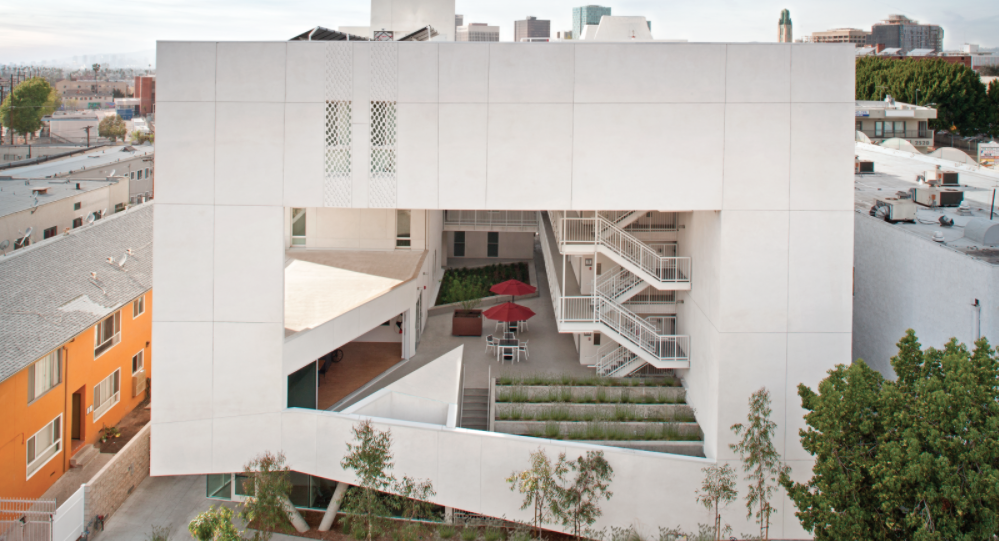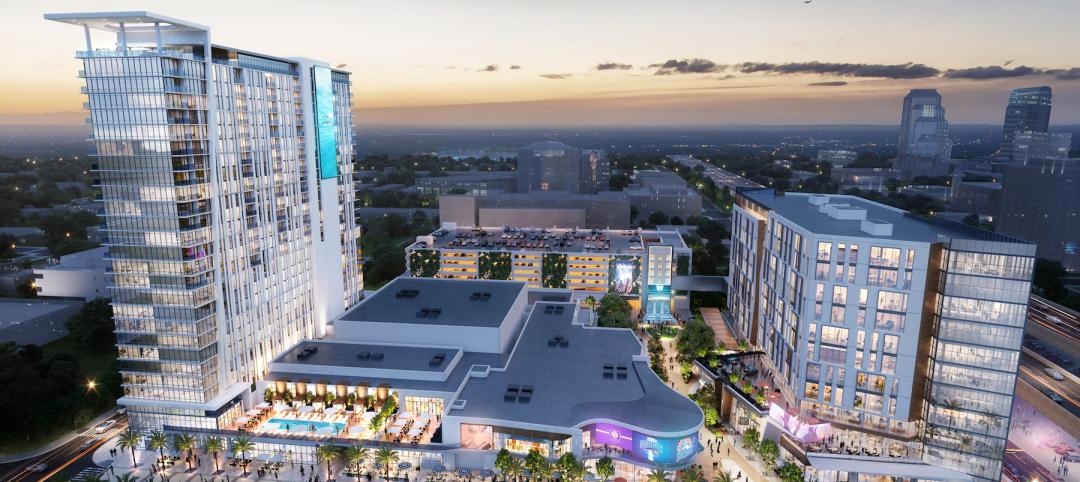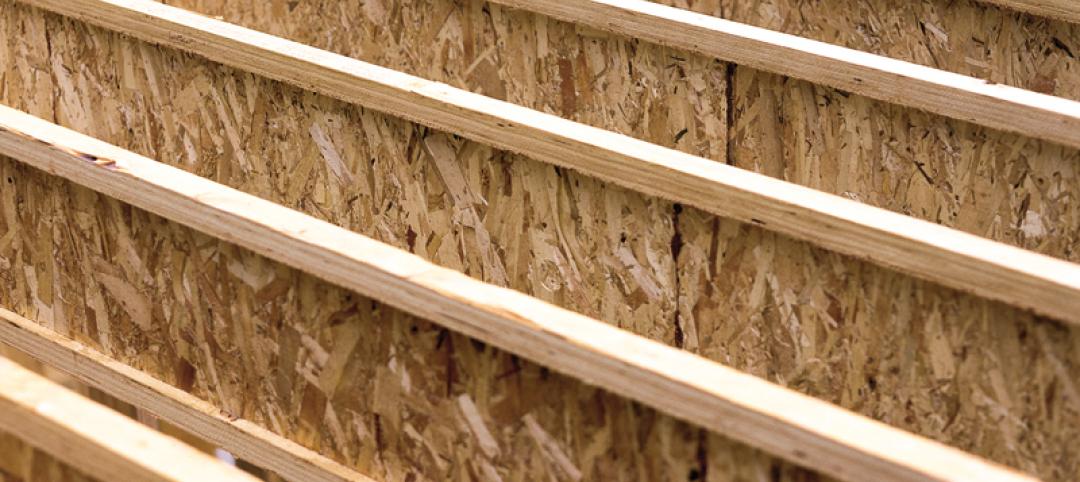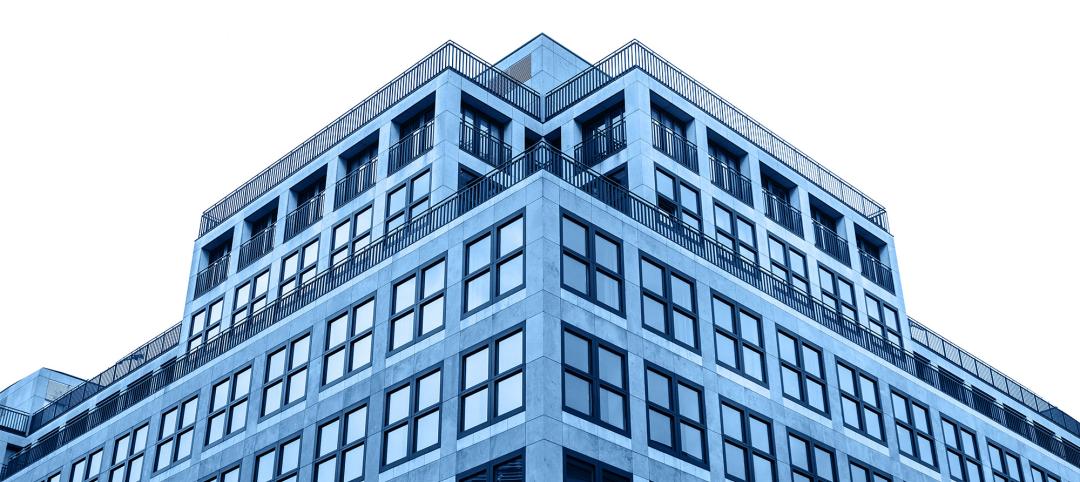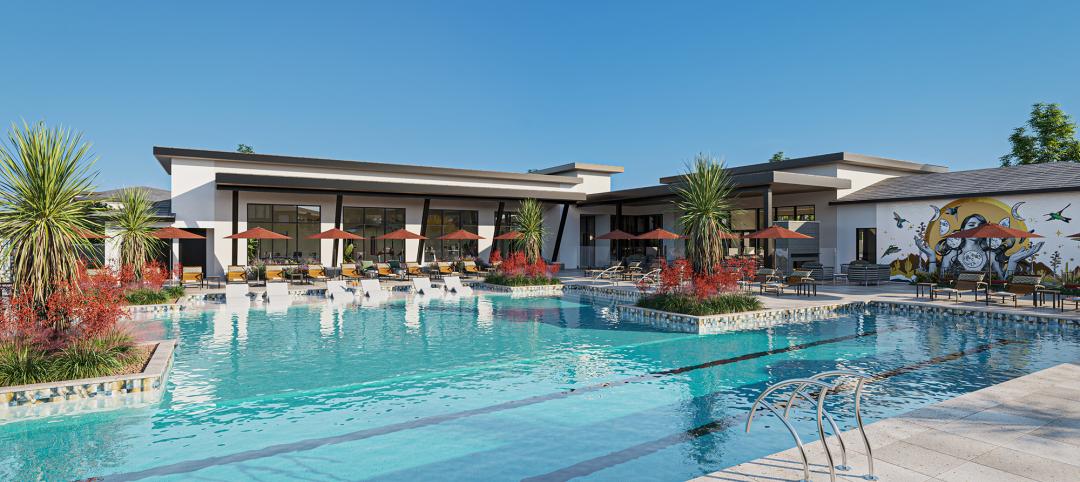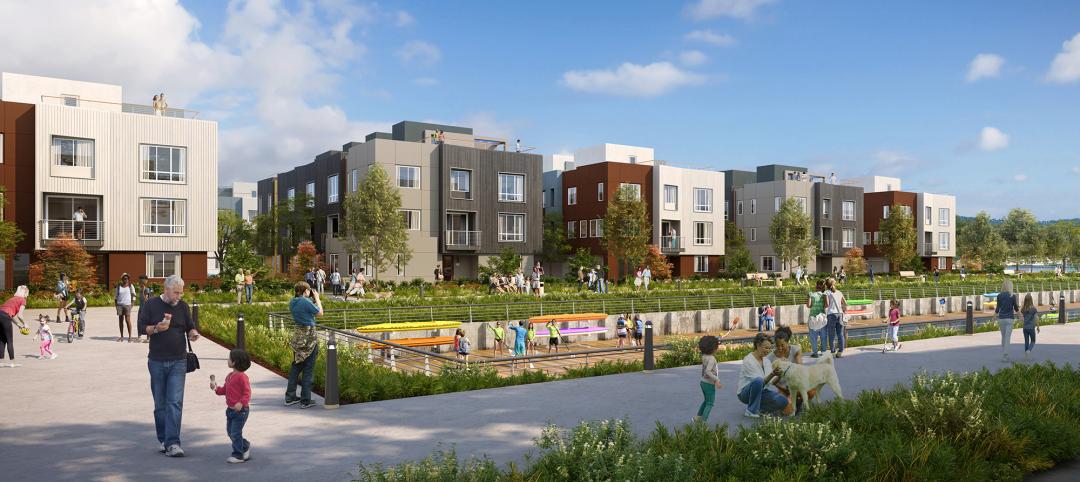For the homeless, the experience of obtaining social services, whether in a soup kitchen, shelter, or free clinic, often means having to encounter institutional buildings marked by dingy walls, stained floors, and annoying fluorescent lights.
“The message people get is, ‘We don’t really care very much about you,’” says Mike Alvidrez, CEO, Skid Row Housing Trust, Los Angeles. “We don’t see that as a healthy way to change one’s life.”
Alvidrez says it’s almost impossible for people to overcome mental, social, and medical problems while they’re homeless. Skid Row Housing Trust’s approach is to provide housing first, so that problems emanating from prolonged poverty, poor health, disabilities, mental illness, or addiction can be addressed, and people can go on to lead “safe, stable lives in wellness.”
To fulfill that mission, Skid Row Housing Trust works with award-winning architects to create masterfully designed “supportive” apartment buildings. “We want these buildings to feel inspirational and aspirational, so residents feel proud of where they live and aspire to do more,” says Alvidrez.
That philosophy certainly applies to The Six, an 18,390-sf building designed by Los Angeles–based Brooks + Scarpa. The Six provides 52 apartments and studio efficiencies for formerly homeless individuals; 18 of the units have been set aside for veterans. The name comes from the military expression “Got your six,” meaning “I’ve got your back.”
DESIGNING A PLACE FOR HEALING
The Six is located at 811 South Carondelet Street in MacArthur Park, one of the highest-density neighborhoods in the U. S.—38,000 per square mile. The architects were aware that successful recovery and rehabilitation for Skid Row Housing’s clients depended on the ability of formerly homeless individuals to be reintroduced into society.
The design of The Six purposely deemphasizes personal space in favor of community space where residents can make connections organically—to others, and to their surroundings.
“Projects like this tend to become very large compact masses, and light and ventilation become real problems,” says Lawrence Scarpa, FAIA, LEED AP, CEO, Brooks + Scarpa. “We wanted the units to be open and light-filled, with good cross-ventilation, and still have privacy for tenants.”

The view from the second-floor podium courtyard into the community room. “For the veterans and other tenants who are suffering from schizophrenia and other problems, the courtyard and community room get them to be among other people,” says Lead Designer Larry Scarpa, FAIA. Photo: Tara Wujcik
The solution was to create a huge five-story white cube with massive holes punched into three sides. Skid Row Housing’s Alvidrez admits that The Six really stands out. “Let’s face it, it’s a box, but, man, what a box!” he says. “The opening in the front is what you notice first: ‘Hey, there’s a big hole in that building. What the hell is that about?’ It sets up a conversation with the community. Homelessness is something we need to talk about. The solution needs to be loud and proud.”
The varying size of the punched holes induces cross-ventilation that takes advantage of the local climate and prevailing breezes. “The air really flows through,” says Brooks + Scarpa Design/Project Manager Diane Thepkhounphithack. The units have huge casement windows that catch the wind. Transom windows over the entry doors allow air and light to penetrate the living spaces.
The emphasis on natural light and airflow reinforces the designers’ focus on promoting physical and emotional healing. “With any form of recovery, being exposed to light, ventilation, and beautiful weather can make a huge difference,” Thepkhounphithack says.
GIVING TENANTS MEANINGFUL OPTIONS
To encourage residents to get out and about instead of hunkering in their rooms, the 45 studio efficiencies (350 sf) and seven one-bedroom units (500 sf) provide just enough room for a bed, bathroom, and small kitchen. Rents are based on income.
The organic nature of the pierced walls opens up an extensive courtyard on the second floor that connects to a community space with sliding glass doors (which are usually kept open during the day). This nexus between the courtyard and the community space can, depending on the needs of the tenant, provide opportunity either for involvement with others, or for privacy.
“Our task was to allow people to interact with others, but at their own choosing,” says Scarpa. “The community room is wide open and connects to the courtyard, so people can interact but still be part of the bigger space.”
The open frame of the building gives residents a feeling of privacy despite the intense density of the neighborhood. “As soon as you put a frame around something, you feel a sense of separation, in a good way,” says Thepkhounphithack. “When you’re on the podium deck, technically you’re exposed because people can see in, but you feel pulled back, and you still have a sense of privacy.”

James Grahn, 53 (right, with residents Tony Hill and Robert Odom), served in the Army Signal Corps in Germany, Texas, and California (1982 to 1991), then did a stint in the National Guard (2001 to 2011). “I had a lot of fun in the army,” he says. Before moving to The Six in May, Grahn lived in a friend’s RV, then wound up in a VA hospital. His last stop was a homeless shelter in downtown LA.
Pathways through the building lead to the staircase that connects to the residential units on the upper floors of the five-story structure. That wayfinding pattern was carefully choreographed.
“It’s not the most efficient way to get around,” says Thepkhounphithack. “The pathways are meant to be meandering, to encourage residents to get outside in communal spaces in order to socialize and reconnect with the community.”
Diana Pescar, Resident Services Coordinator with Skid Row Housing , says she’s pleasantly surprised at how well the community space is working. “They’re playing dominoes out there on the picnic tables, stuff you’d see on Skid Row, but now they’re in this safe environment.”
PROVIDING SORELY NEEDED SERVICES
As with all Skid Row Housing projects, The Six has on-site supportive services: primary medical and mental healthcare, individual and group counseling, health and dental screenings, addiction recovery support, and assistance with obtaining government entitlements.
Three case managers—Pescar, Daniel Myatt, and Shanknika Ainsworth—provide intensive case management for all residents, including peer-group counseling, crisis intervention, and hands-on help with applications for Social Security disability and veterans’ benefits. “Because they’ve been homeless, our residents often don’t have their birth certificates or discharge papers,” says Pescar. “We have a direct line to the VA and can get those documents.”
To foster interaction among the residents, the case managers offer classes in improv acting, music appreciation, cooking on a budget, and flower arrangement. Pescar, who has a degree in art education, says she initially got a lot of grief about the flower class. “Oh, the guys’ll never come! That’s all I heard.” But the class is full every week. “That class has taught me that these men have interests that you wouldn’t think possible—aesthetics, gardening, music,” says Pescar.
NO SHORTAGE OF PROBLEMS TO SOLVE
The Six’s team faced more than its fair share of hurdles. The design was well under way when the project had to be moved to a new site. “We had to scramble to produce a quick concept design to show lenders the project was still viable,” says Thepkhounphithack.
The complicated funding package created another set of problems. Skid Row Housing Trust pulled together $10.1 million from a wide array of sources: National Equity Fund, Los Angeles Housing + Community Investment Department, Housing Authority of the City of Los Angeles, Los Angeles County Department of Health Services, California Tax Credit Allocation Committee, Local Initiatives Support Corp., Federal Home Loan Bank of San Francisco, Charles Schwab Bank, Century Housing Corp., and Wells Fargo.

Mechanical systems are enclosed in decorative sculptural forms. “We worked hard to consolidate hundreds of shafts and exhausts so that our roof wouldn’t become a big mechanical zone,” says Larry Scarpa. Photo: Tara Wujcik
The lenders imposed strict—and immovable—timelines on the team. “If you miss the timeline, they revoke your funding. No fees or fines, they just take your money back,” Thepkhounphithack says. It was a constant race against the clock. Very late in the construction schedule, they discovered a misunderstanding about one lender’s deadline. “We had to finish one or two months earlier than scheduled,” she says. The general conrtractor, Golden Bear Construction, had to frame entire floors in a week.
Permitting also proved a headache. Some of the newer materials the team wanted to use, while not that unusual—for example, a new wood composite screen material—the building department wouldn’t allow because its research department hadn’t tested it.
“What’s good enough for every other building department in the world is not good enough for LA,” says Scarpa. Says Thepkhounphithack, “It was an intense process. We basically lived in the building department.”
MAKING A BOLD STATEMENT
The architectural style of The Six was clearly intended to stand out. Thepkhounphithack says the design of the building was about “propelling the neighborhood forward,” rather than just blending in.
The all-white façade of the five-story structure brings a brightness and tranquility to the building and provides a background to the landscaping (by LandStudio 360 and Brooks + Scarpa). The grass in the planters is bright pink when in bloom; the roof plants are red hot pokers. The stark façade provides a dramatic backsplash to these piercing colors as they come into season and change with time, she says.
In addition to earning LEED for Homes Platinum certification, The Six has already captured a slew of prizes: 2017 National AIA Institute Honor, AIA National Housing Award, AIA California Council Honor Award, AIALA Honor Award, and AIA Sustainability Honor Award.
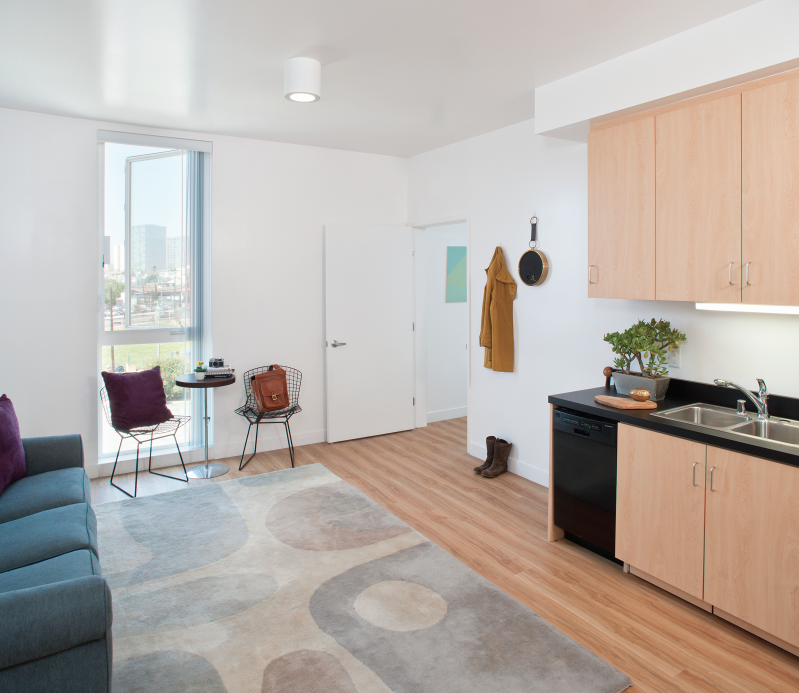
Luxury sheet vinyl flooring helps keep maintenance under control at The Six. Walls were done in semi-gloss paint (level-four smooth finish) for easy cleaning. Units are ADA-adaptable, with zero-step thresholds and roll-in showers or tubs. Photo: Tara Wujcik
For the project team, the true reward has come in how The Six is helping provide elegant housing at affordable rates to those who were previously on the street. This is especially true for the veterans. Says Thepkhounphithack, “It’s good to have them be part of the future instead of being stuck in the past.”
The biggest benefit for the veterans and other formerly homeless residents, says Skid Row Housing Trust’s Diana Pescar, is that The Six induces “a sense of pride about being deserving of living in a nice place.” Her boss, Mike Alvidrez, puts it this way: “We want them to feel proud that this is their home, their community.”
PROJECT TEAM | THE SIX, LOS ANGELES
CLIENT Skid Row Housing Trust, LLC ARCHITECT Brooks + Scarpa STRUCTURAL ENGINEER John Martin & Associates CIVIL ENGINEER Barbara L. Hall, PE MEP ENGINEER Innovative Engineering Group SPECIFICATIONS Phil Easton LANDSCAPE ARCHITECT Brooks + Scarpa; LandStudio 360 GENERAL CONTRACTOR Golden Bear Construction
Related Stories
Senior Living Design | Apr 24, 2024
Nation's largest Passive House senior living facility completed in Portland, Ore.
Construction of Parkview, a high-rise expansion of a Continuing Care Retirement Community (CCRC) in Portland, Ore., completed recently. The senior living facility is touted as the largest Passive House structure on the West Coast, and the largest Passive House senior living building in the country.
ProConnect Events | Apr 23, 2024
5 more ProConnect events scheduled for 2024, including all-new 'AEC Giants'
SGC Horizon present 7 ProConnect events in 2024.
Mixed-Use | Apr 23, 2024
A sports entertainment district is approved for downtown Orlando
This $500 million mixed-use development will take up nearly nine blocks.
Resiliency | Apr 22, 2024
Controversy erupts in Florida over how homes are being rebuilt after Hurricane Ian
The Federal Emergency Management Agency recently sent a letter to officials in Lee County, Florida alleging that hundreds of homes were rebuilt in violation of the agency’s rules following Hurricane Ian. The letter provoked a sharp backlash as homeowners struggle to rebuild following the devastating 2022 storm that destroyed a large swath of the county.
Student Housing | Apr 19, 2024
$115 million Cal State Long Beach student housing project will add 424 beds
A new $115 million project recently broke ground at California State University, Long Beach (CSULB) that will add housing for 424 students at below-market rates. The 108,000 sf La Playa Residence Hall, funded by the State of California’s Higher Education Student Housing Grant Program, will consist of three five-story structures connected by bridges.
Sponsored | Multifamily Housing | Apr 19, 2024
5 Reasons to Opt for Wood I-Joists in Multifamily Construction
From versatility to reliability and adaptability, engineered wood I-joists offer builders, designers and developers numerous advantages in multifamily construction. Discover the top five benefits and handy installation tips.
MFPRO+ News | Apr 18, 2024
Marquette Companies forms alliance with Orion Residential Advisors
Marquette Companies, a national leader in multifamily development, investment, and management, announces its strategic alliance with Deerfield, Ill.-based Orion Residential Advisors, an integrated multifamily investment and operating firm active in multiple markets nationwide.
MFPRO+ New Projects | Apr 16, 2024
Marvel-designed Gowanus Green will offer 955 affordable rental units in Brooklyn
The community consists of approximately 955 units of 100% affordable housing, 28,000 sf of neighborhood service retail and community space, a site for a new public school, and a new 1.5-acre public park.
MFPRO+ News | Apr 15, 2024
Two multifamily management firms merge together
MEB Management Services, a Phoenix-based multifamily management company, and Weller Management, a third-party property management and consulting company, officially merged to become Bryten Real Estate Partners—creating a nationally recognized management company.
Mixed-Use | Apr 13, 2024
Former industrial marina gets adaptive reuse treatment
At its core, adaptive reuse is an active reimagining of the built environment in ways that serve the communities who use it. Successful adaptive reuse uncovers the latent potential in a place and uses it to meet people’s present needs.


